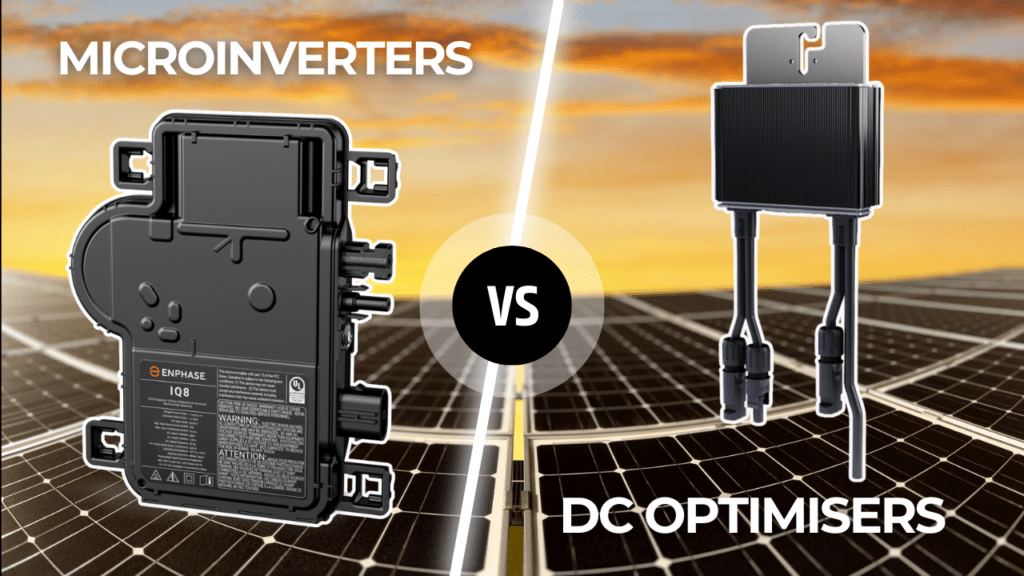
In the solar installation industry, there are generally two types of systems and they each have a loyal following: the string inverter camp and the microinverter camp. Which one should you invest in?
Honestly, that answer is going to be different for everyone. What works for one customer is useless for another. Your needs are unique, and your energy goals will be unique as well. This will inform your investment.
The DC optimiser was added to string inverter solar systems so they could match the efficiency of a microinverter solar system. And while they are completely different types of technologies that do completely different things, both work with your solar panels to increase the efficiency of your solar system.
At Penrith Solar Centre, we exclusively install microinverter solar systems. However, we realise that our solution for most people’s unique needs and solar goals will be different. In that spirit, we’re simply trying to educate in an unbiased manner. You might prefer one over the other depending on your needs. All that really matters is that we’re working to get Australia to Net Zero by 2050.
In this article, you will learn:
- How Does a String Inverter System Work?
- What is a DC Optimiser?
- What is Maximum Power Point Tracking (MPPT)?
- Pros and Cons of DC Optimisers
- Pros and Cons of Microinverters
- Common Ground Between Microinverters & DC Optimisers
By the end of this article, you’ll have a comprehensive understanding of DC optimisers and how they’re different from microinverters.
How Does a String Inverter System Work?
An “inverter” in the solar industry is a component of a solar system that converts direct current (DC) power to alternating current (AC) power. It’s an important part of your solar system because the panels are only able to output DC power and your home (lights, appliances, etc.) requires AC power to function.
In a string inverter solar system, the inverter is installed somewhere on the side of the house. The solar panels on the roof send the DC power down to the inverter for conversion to AC power. From there, the electricity is sent to the home, or a battery (if you have one), or the grid for a feed-in tariff.
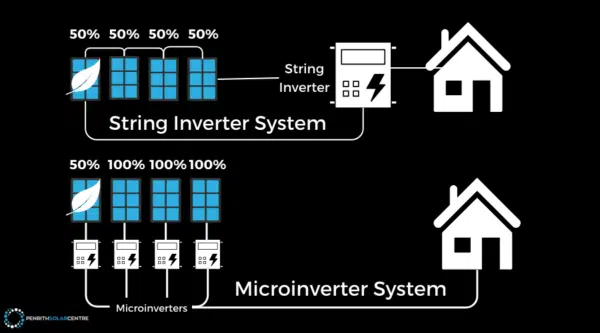
A microinverter solar system is a little different from a string inverter solar system. Instead of installing an inverter on the side of the house, the microinverter is an individual inverter that is mounted beneath each solar panel.
The microinverter converts the DC power to AC power at that point in the system and then sends AC power down to the home to power the lights, appliances, and anything else (or powering a battery (if you have one) or sends it to the grid for a feed-in tariff).
A string inverter solar system works like Christmas lights: when one light goes dark, the rest of the lights in the string go dark. Of course, it’s a little more complex than that, but that’s the general idea.
String inverter systems are less efficient than microinverter solar systems. When one panel drops in efficiency, the rest of the panels drop to match that level of output. The productivity of the entire solar system drops to match what that weakest performer in the string is capable of.
Microinverters don’t have this problem. A microinverter is an individual inverter mounted underneath each solar panel. Because of this, each panel can operate efficiently on their own and output as much as that individual panel is able to without being affected by the others.
A string system attached to a central inverter monitors and converts power for the entire string, while a microinverter monitors and converts power for an individual solar panel.
Before the widespread adoption of DC optimisers, string systems just couldn’t keep up with the efficiency of microinverters.
If you’re interested in learning more about the differences between microinverters and string inverters, you might want to check out the following article titled, Microinverters vs. String Inverters: An Honest Comparison.
What is a DC Optimiser?
Why invest in a solar system where all the panels match the lowest-performing panel?
String inverter solar system companies needed a solution to this inherent problem in their systems – especially once microinverters started to solve this problem for them.
Enter the DC optimiser.
DC optimisers increase the efficiency of a solar system in a completely different way than microinverters do.
A microinverter converts DC power to AC power. It inherently enhances performance in each solar panel by being its own superintendent for harvesting sunshine production at the panel level.
A DC optimiser is a DC-to-DC converter that converts DC voltage to a higher or lower level of DC voltage.
Like microinverters, a DC optimiser is mounted underneath each solar panel. They also feature the ability to track and monitor solar system performance at the panel level. This is a huge win in the evolution of a string inverter solar system.
By utilising similar panel-level monitoring technologies, DC optimisers take the information about how efficiently the panels are performing and adjusts the DC output to improve the efficiency of the whole string.

Adjusting the DC output of the other solar panels is done using an algorithm that squeezes as much power out of your solar panels as possible. This is called Maximum Power Point Tracking (MPPT), and we’ll get into it shortly.
A DC optimiser acts as a bypass switch for the underperforming panel. The underperforming panel is ignored and unable to bring the entire string of panels down to its output, as is usually the case with string solar systems.
Essentially, manufacturers are targeting the problem of a string system’s inefficiencies by making it more like a microinverter solar system.
If you’re interested in learning more about monitoring the efficiency of your solar system, you might want to check out the following article titled, What is Consumption Monitoring?
What is Maximum Power Point Tracking (MPPT)?
The MPPT feature is software in the solar system that helps solar panels work at their best, even when things like sunlight strength and temperature change.
It uses special algorithms to adjust how the solar panels work, making sure they produce the most energy possible all the time. By constantly tweaking how the panels operate, MPPT reduces any energy loss caused by changes in the environment.
This makes the solar power system perform better overall and produce more energy.
But how does it do this? Isn’t the amount of electricity harvested from solar panels fixed? Isn’t that science?
Well, we found this post on Quora.com that sums it up well by way of Solarchoice.net. Here’s the explanation:
“An MPPT tracker is analogous to a thumb placed over a garden hose. If you put your thumb over part of the opening of the hose (adding resistance to the circuit), the pressure (voltage) goes up and the stream flies faster, but less water (current) is getting through. If you completely cover the opening, nothing gets through. If you remove your thumb entirely, the maximum flow rate gets through, but the stream falls limply at your feet. That’s the basic mechanism of the MPPT tracker: vary resistance in the circuit to modify current and voltage.
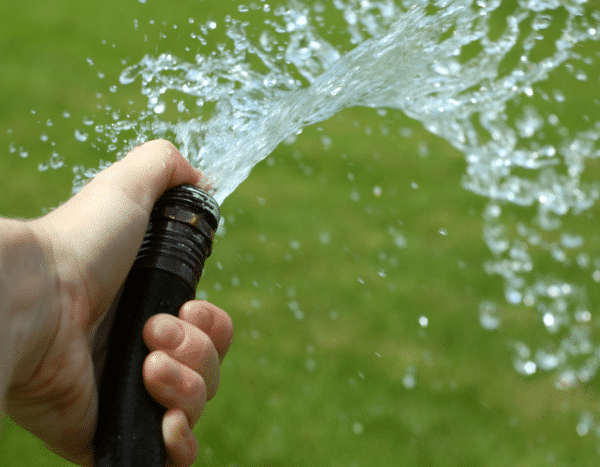
Now imagine that there are hundreds of pumps (solar panels) upstream of the hose and they are delivering water (energy) to you. Further complicating things, some of these pumps go offline at certain parts of the day (partial shading of the array). So the force behind the delivery of water will be constantly varying.
Your task is to wash your car, which is sitting still about 15 feet away. You need to keep moving your thumb as the upstream pump force varies in order to avoid undershooting or overshooting the car. The “car” in this case is the Maximum Power Point – for any array of solar panels, there is a configuration of current and voltage that aligns with maximum power generation.
The MPPT tracker varies resistance in order to keep hitting this point, using control logic to stay at the maximum just like a thermostat or cruise control.”
Maximum Power Point Trackers (MPPT) are crucial in solar power systems because they make sure the system produces as much energy as possible and works well overall.
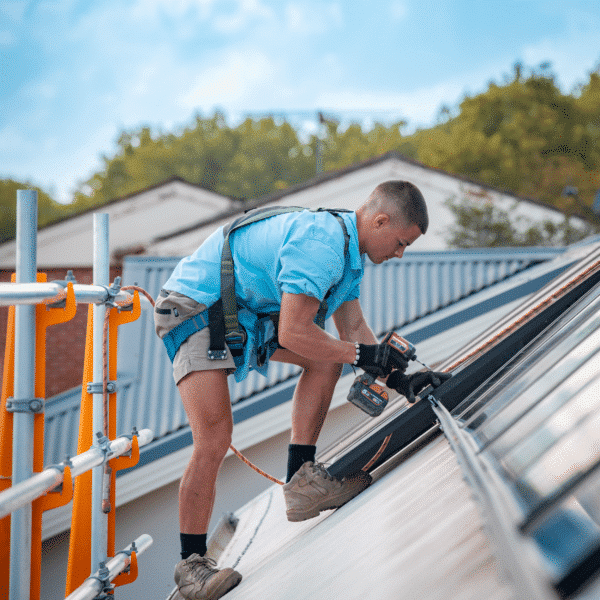
Here’s why MPPT matters:
Maximizing Energy Yield: MPPT keeps adjusting how solar panels work to get the most power from the sunlight available. This helps the solar power system produce the most energy it can, which is important for getting the most out of the system.
Adapting to Changing Conditions: Sunlight, temperature, and shade can change, affecting how well solar panels work. MPPT technology reacts to these changes, making sure the system works at its best in different situations. This is important for keeping the system running well all the time.
Increasing Solar System Efficiency: By adjusting how solar panels work, MPPT prevents energy loss that can happen with fixed settings. This makes the system more efficient at turning sunlight into electricity, which is important for making the most of renewable energy.
Handling Partial Shading of PV Modules: MPPT is great at dealing with shading on solar panels. If only part of the solar panels are shaded, MPPT lets the unshaded parts work at full power, reducing the overall energy loss.
Enhancing Return on Investment (ROI): When MPPT helps the system produce more energy, it means more money is saved or earned over time. This makes the investment in solar power even more worthwhile, ensuring the system runs efficiently and generates as much electricity as possible.
If you’re interested in learning more about the payback period of your solar system, you might want to check out the following article titled, What is the Payback Period for Solar Panels in Australia?
Pros and Cons of DC Optimisers
There are advantages and disadvantages to DC optimisers. Let’s look at them:
Pros:
- Optimisers boost the voltage of panels to compensate for partial shading or panels on different roof faces where the panels are facing different directions.
- Real-time monitoring is crucial for an efficient-running solar system. The fancy pants solar vocabulary word for this is called consumption monitoring and we have an article about that (linked below).

Cons:
- There aren’t a lot of options for optimisers right now. In Australia, there are Tigo optimisers (which are brand agnostic) and SolarEdge optimisers (which only work with SolarEdge systems). If you don’t have a SolarEdge string system, then your only option is Tigo.
- The installation of optimisers takes time, which increases the cost of installation. They’re mounted under every solar panel like a microinverter, and by the time you pay for the additional equipment to your string system and the cost to install it, you’re almost as expensive as a microinverter solar system.
- While the optimiser does a lot to boost the performance of a string solar system, it is still a string solar system. It’s subject to most of the same problems inherent in a string system. There is still a central point of failure. If there’s an issue with the inverter on the side of the house, the whole system underperforms or shuts down.
If you’re interested in learning more about which type of solar system you want based on your energy needs and goals, you might want to check out the following article titled, How Much Solar Do You Need?
Pros and Cons of Microinverters
There are advantages and disadvantages to microinverters. Let’s look at those too:
Pros:
- Real-time monitoring at the panel level is more sophisticated than real-time monitoring for optimisers. Optimisers will notify you of an underperforming string system, but a microinverter will notify you of an underperforming panel.
- Microinverters have been around longer and withstood more real-world inclement weather and scorching temperatures (and testing for it too).
- Microinverters immediately convert volatile DC power to AC power, protecting homeowners from high-voltage cable runs along the length of their homes.

Cons:
- Cost is the biggest drawback of microinverter solar systems.
If you’re interested in learning more about the microinverter solar systems, you might want to check out the following article titled, Myths & Misconceptions About Solar Microinverters.
Common Ground Between Microinverters & DC Optimisers
While their differences are many, the DC optimiser was invented to navigate the problems with string inverter solar systems. In essence, these devices were created to make string systems more like microinverter solar systems.
So how successful were those string system manufacturers? What do microinverters and DC optimisers have in common?
Cost: It’s difficult to estimate the cost of any solar installation because the specifics are so unique for each install, but a string system with optimisers costs about the same as a microinverter solar system.
Efficiency: Both microinverters and DC optimisers are more efficient than string inverter solar systems. Micros and optimisers troubleshoot problems like panel mismatch, underperforming panels, and other things like temperature differences. Although they do this in different ways, the result is the same: improved efficiency.
Panel Orientation: When you have multiple panels facing different directions, you need microinverters or optimisers for that system to work.
Warranty: Both microinverters and optimisers are generally covered by warranty for 15 – 25 years depending on the manufacturer, region, and any extensions that may or may not have been added.
If you’re interested in learning more about the importance of warranties when shopping for a solar system, you might want to check out the following article titled, A Complete Guide to Solar Warranties.
Keeping Your Watts About You as You Shop for Solar
Now that you understand what a DC optimiser is and the differences between optimisers and microinverters, you’ll be better informed to make some decisions around your solar system. Choosing an inverter will determine the type of system you get behind: strings or micros.
If you choose to go strings and add optimisers to the system, you will benefit from most of the advantages of a microinverter solar system (though not all of them). Even with optimisers, a string system is still locked in by the technological disadvantage of a central point of failure. And that system will only be marginally cheaper than a microinverter system.
It’s a lot to consider.
At Penrith Solar Centre, want you to know – comprehensively – about the advantages and disadvantages of optimisers in comparison to microinverters. It’s a decision that will affect your electricity bills for multiple decades (potentially). We want you to make an informed choice for your unique needs and goals.
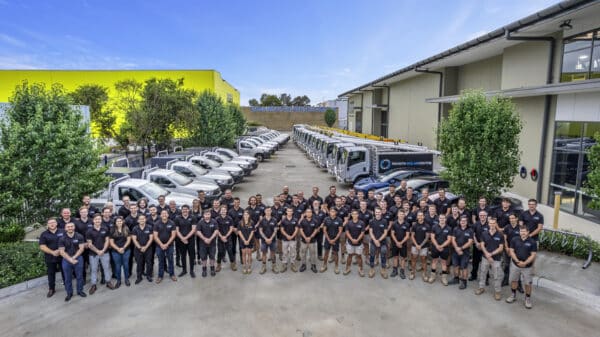
If you’re interested in learning more about what to prioritise when pricing a solar system, you might want to check out the following article titled, How to Shop for Your Solar System.









